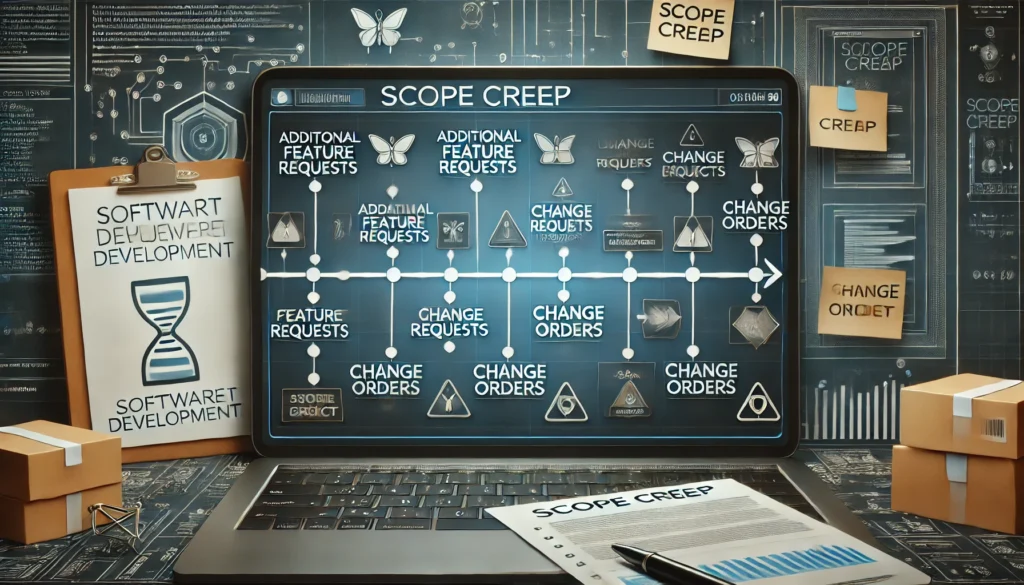
Scope Creep in Software Development:
Causes, Impacts, and Strategies to Control It
Introduction
Have you ever worked on a software project that started with a well-defined scope but gradually expanded to include additional features, functionalities, or design changes? That’s Scope Creep—a common challenge in software development that can lead to missed deadlines, increased costs, and frustrated development teams.
Scope creep happens when new requirements are introduced after the project has started, often without proper evaluation of their impact on timelines, resources, or budgets. While some flexibility is necessary in software development, uncontrolled scope creep can derail even the most well-planned projects.
In this guide, we’ll explore scope creep in software development, its causes, impacts, real-world examples, and best practices to manage it effectively.
What is Scope Creep in Software Development?
In software development, scope creep occurs when new features, functionalities, or enhancements are introduced without going through a structured approval process. Unlike planned scope changes that follow change management protocols, scope creep usually happens informally, often due to evolving client requirements, market trends, or lack of clarity in project goals.
For example, a client might initially request a simple e-commerce website, but over time, they start adding:
✅ AI-powered chatbots
✅ Personalized recommendations
✅ Advanced analytics dashboards
✅ Third-party integrations
While these features may improve the product, adding them without adjusting deadlines, budgets, or resources leads to scope creep—causing project delays and overworked teams.
Common Causes of Scope Creep in Software Projects
1. Unclear Requirements and Initial Scope
One of the biggest reasons for scope creep is poorly defined software requirements. If the client or development team doesn’t have a detailed Software Requirement Specification (SRS), new requests will keep emerging throughout the project lifecycle.
2. Frequent Changes in Business Needs
In the tech industry, market trends change rapidly, and businesses often try to keep up by continuously tweaking software functionality. This is especially true for startups and SaaS companies that frequently pivot their strategies.
3. Lack of a Proper Change Management Process
When new feature requests are accepted without assessing their impact on development time, testing, and deployment, the project scope expands uncontrollably.
4. Poor Communication Between Stakeholders
Misalignment between clients, developers, designers, and testers often leads to scope creep. If expectations are not clearly set at the start, stakeholders may keep requesting additional features, assuming they are minor adjustments.
5. Over-Promising in Agile Development
While Agile methodologies encourage adaptability, an undisciplined approach can lead to excessive backlog items, making it difficult to maintain project focus. Frequent sprint modifications without proper prioritization result in scope creep.
6. “Gold Plating” by Developers
Sometimes, developers exceed client requirements by adding extra features or functionalities that were not requested. While the intention is to improve the product, this can increase development time and technical debt.
7. Client-Induced Feature Creep
Clients often request “just one more feature” without realizing the impact on development timelines. When these minor changes accumulate, they cause significant deviations from the original plan.
The Impact of Scope Creep on Software Development
Unchecked scope creep can have severe consequences in software projects:
🚨 Missed Deadlines: Every new addition requires development, testing, and deployment time, causing delays.
💰 Budget Overruns: More features mean more developer hours, increasing costs.
😓 Developer Burnout: Teams working on an ever-expanding project experience stress and reduced productivity.
🛠️ Technical Debt: Rushed development due to added scope can lead to poor code quality and increased maintenance costs.
❌ Project Failure: In extreme cases, uncontrolled scope creep can cause projects to be abandoned altogether.
Real-World Examples of Scope Creep in Software Development
Example 1: Healthcare.gov (The Affordable Care Act Website)
Initially planned as a simple online healthcare enrollment system, Healthcare.gov suffered massive scope creep due to last-minute regulatory changes, stakeholder demands, and security concerns. The result?


Example 2: Windows Vista Development
Microsoft’s Windows Vista suffered from uncontrolled feature additions. Originally intended as a lightweight and efficient OS, it expanded to include advanced graphics, new security features, and UI overhauls—resulting in multiple delays and user dissatisfaction.
How to Prevent Scope Creep in Software Projects
1. Define a Clear and Detailed Scope
Use a Software Requirement Specification (SRS) document to clearly outline:



A Product Roadmap can also help set long-term expectations for feature rollouts.
2. Implement a Strict Change Control Process
Before adding new features, follow a structured process:



This ensures that every new feature is evaluated and justified before implementation.
3. Use Agile Methodologies with Strong Backlog Management
Agile development allows flexibility, but it’s essential to prioritize features properly.


4. Establish Clear Communication Channels
Regular stakeholder meetings and project updates help align expectations.


5. Set Up Strong Client Expectation Management
Clients need to understand that every new feature affects timelines and costs.


6. Avoid Gold Plating
Developers should focus on delivering what is requested, not adding extras.


7. Use Prototyping and Wireframes
Before jumping into development, use:


This prevents midway design changes that contribute to scope creep.
Handling Scope Creep When It Happens
If scope creep occurs:




Conclusion
Scope creep is an unavoidable challenge in software development, but with the right strategies, it can be controlled and managed effectively.
✅ Start with a well-defined SRS document
✅ Use Agile backlog prioritization
✅ Set realistic client expectations
✅ Implement a formal change control process
By maintaining clear communication, proper documentation, and structured workflows, software development teams can deliver successful projects without falling into the trap of uncontrolled scope creep.
💬 Have you experienced scope creep in your projects? Share your thoughts below! 🚀
